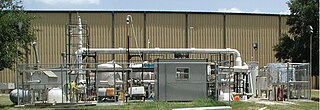Related Research Articles

Biofuel is a fuel that is produced over a short time span from biomass, rather than by the very slow natural processes involved in the formation of fossil fuels, such as oil. Biofuel can be produced from plants or from agricultural, domestic or industrial biowaste.
Syngas, or synthesis gas, is a mixture of hydrogen and carbon monoxide, in various ratios. The gas often contains some carbon dioxide and methane. It is principally used for producing ammonia or methanol. Syngas is combustible and can be used as a fuel. Historically, it has been used as a replacement for gasoline, when gasoline supply has been limited; for example, wood gas was used to power cars in Europe during WWII.
The Fischer–Tropsch process is a collection of chemical reactions that converts a mixture of carbon monoxide and hydrogen, known as syngas, into liquid hydrocarbons. These reactions occur in the presence of metal catalysts, typically at temperatures of 150–300 °C (302–572 °F) and pressures of one to several tens of atmospheres. The Fischer–Tropsch process is an important reaction in both coal liquefaction and gas to liquids technology for producing liquid hydrocarbons.
Cellulosic ethanol is ethanol produced from cellulose rather than from the plant's seeds or fruit. It can be produced from grasses, wood, algae, or other plants. It is generally discussed for use as a biofuel. The carbon dioxide that plants absorb as they grow offsets some of the carbon dioxide emitted when ethanol made from them is burned, so cellulosic ethanol fuel has the potential to have a lower carbon footprint than fossil fuels.

Synthetic fuel or synfuel is a liquid fuel, or sometimes gaseous fuel, obtained from syngas, a mixture of carbon monoxide and hydrogen, in which the syngas was derived from gasification of solid feedstocks such as coal or biomass or by reforming of natural gas.

Biomass to liquid is a multi-step process of producing synthetic hydrocarbon fuels made from biomass via a thermochemical route.

Gas to liquids (GTL) is a refinery process to convert natural gas or other gaseous hydrocarbons into longer-chain hydrocarbons, such as gasoline or diesel fuel. Methane-rich gases are converted into liquid synthetic fuels. Two general strategies exist: (i) direct partial combustion of methane to methanol and (ii) Fischer–Tropsch-like processes that convert carbon monoxide and hydrogen into hydrocarbons. Strategy ii is followed by diverse methods to convert the hydrogen-carbon monoxide mixtures to liquids. Direct partial combustion has been demonstrated in nature but not replicated commercially. Technologies reliant on partial combustion have been commercialized mainly in regions where natural gas is inexpensive.
Acetogenesis is a process through which acetate is produced either by the reduction of CO2 or by the reduction of organic acids, rather than by the oxidative breakdown of carbohydrates or ethanol, as with acetic acid bacteria.

Various alcohols are used as fuel for internal combustion engines. The first four aliphatic alcohols are of interest as fuels because they can be synthesized chemically or biologically, and they have characteristics which allow them to be used in internal combustion engines. The general chemical formula for alcohol fuel is CnH2n+1OH.
Bioconversion, also known as biotransformation, is the conversion of organic materials, such as plant or animal waste, into usable products or energy sources by biological processes or agents, such as certain microorganisms. One example is the industrial production of cortisone, which one step is the bioconversion of progesterone to 11-alpha-Hydroxyprogesterone by Rhizopus nigricans. Another example is the bioconversion of glycerol to 1,3-propanediol, which is part of scientific research for many decades.

The bioconversion of biomass to mixed alcohol fuels can be accomplished using the MixAlco process. Through bioconversion of biomass to a mixed alcohol fuel, more energy from the biomass will end up as liquid fuels than in converting biomass to ethanol by yeast fermentation.

Lignocellulose refers to plant dry matter (biomass), so called lignocellulosic biomass. It is the most abundantly available raw material on the Earth for the production of biofuels. It is composed of two kinds of carbohydrate polymers, cellulose and hemicellulose, and an aromatic-rich polymer called lignin. Any biomass rich in cellulose, hemicelluloses, and lignin are commonly referred to as lignocellulosic biomass. Each component has a distinct chemical behavior. Being a composite of three very different components makes the processing of lignocellulose challenging. The evolved resistance to degradation or even separation is referred to as recalcitrance. Overcoming this recalcitrance to produce useful, high value products requires a combination of heat, chemicals, enzymes, and microorganisms. These carbohydrate-containing polymers contain different sugar monomers and they are covalently bound to lignin.

Butanol may be used as a fuel in an internal combustion engine. It is more similar to gasoline than it is to ethanol. A C4-hydrocarbon, butanol is a drop-in fuel and thus works in vehicles designed for use with gasoline without modification. Both n-butanol and isobutanol have been studied as possible fuels. Both can be produced from biomass (as "biobutanol" ) as well as from fossil fuels (as "petrobutanol"). The chemical properties depend on the isomer (n-butanol or isobutanol), not on the production method.

Fermentation is a metabolic process that produces chemical changes in organic substances through the action of enzymes. In biochemistry, it is narrowly defined as the extraction of energy from carbohydrates in the absence of oxygen. In food production, it may more broadly refer to any process in which the activity of microorganisms brings about a desirable change to a foodstuff or beverage. The science of fermentation is known as zymology.

Acetone–butanol–ethanol (ABE) fermentation, also known as the Weizmann process, is a process that uses bacterial fermentation to produce acetone, n-butanol, and ethanol from carbohydrates such as starch and glucose. It was developed by chemist Chaim Weizmann and was the primary process used to produce acetone, which was needed to make cordite, a substance essential for the British war industry during World War I.
Second-generation biofuels, also known as advanced biofuels, are fuels that can be manufactured from various types of non-food biomass. Biomass in this context means plant materials and animal waste used especially as a source of fuel.
In enzymology, carbon monoxide dehydrogenase (CODH) (EC 1.2.7.4) is an enzyme that catalyzes the chemical reaction
Reactive flash volatilization (RFV) is a chemical process that rapidly converts nonvolatile solids and liquids to volatile compounds by thermal decomposition for integration with catalytic chemistries.
Clostridium autoethanogenum is an anaerobic bacterium that produces ethanol from carbon monoxide, in so-called syngas fermentation, being one of the few known microorganisms to do so. It is gram-positive, spore-forming, rod-like, motile, and was first isolated from rabbit feces. Its type strain is strain JA1-1. Its genome has been sequenced and the genes required for utilising carbon monoxide as a sole carbon and energy source have been determined.
E-diesel is a synthetic diesel fuel created by Audi for use in automobiles. Currently, e-diesel is created by an Audi research facility in partnership with a company named Sunfire. The fuel is created from carbon dioxide, water, and electricity with a process powered by renewable energy sources to create a liquid energy carrier called blue crude which is then refined to generate e-diesel. E-diesel is considered to be a carbon-neutral fuel as it does not extract new carbon and the energy sources to drive the process are from carbon-neutral sources. As of April 2015, an Audi A8 driven by Federal Minister of Education and Research in Germany is using the e-diesel fuel.
References
- 1 2 Brown, Robert C. (2003). Biorenewable resources: engineering new products from agriculture. Ames, Iowa: Iowa State Press. ISBN 0-8138-2263-7.
- 1 2 3 Worden, R.M., Bredwell, M.D., and Grethlein, A.J. (1997). Engineering issues in synthesis gas fermentations, Fuels and Chemicals from Biomass. Washington, DC: American Chemical Society, 321-335
- ↑ Abubackar, H.N.; Veiga, M. C.; Kennes, C. (2011). "Biological conversion of carbon monoxide: rich syngas or waste gases to bioethanol" (PDF). Biofuels, Bioproducts and Biorefining. 5 (1): 93–114. doi:10.1002/bbb.256. hdl: 2183/13730 . S2CID 84912109.
- ↑ Sajeev, Evelyn; Shekher, Sheshank; Ogbaga, Chukwuma C.; Desongu, Kwaghtaver S.; Gunes, Burcu; Okolie, Jude A. (June 2023). "Application of Nanoparticles in Bioreactors to Enhance Mass Transfer during Syngas Fermentation". Encyclopedia. 3 (2): 387–395. doi: 10.3390/encyclopedia3020025 .
- ↑ Klasson, K.T.; Ackerson, M. D.; Clausen, E. C.; Gaddy, J.L. (1992). "Bioconversion of synthesis gas into liquid or gaseous fuels". Enzyme and Microbial Technology. 14 (8): 602–608. doi:10.1016/0141-0229(92)90033-K.
- ↑ Abrini, J.; Naveau, H.; Nyns, E.J. (1994). "Clostridium autoethanogenum, sp. nov., an anaerobic bacterium that produces ethanol from carbon monoxide". Archives of Microbiology. 161 (4): 345–351. doi:10.1007/BF00303591. S2CID 206774310.
- ↑ Chang, I. S.; Kim, B. H.; Lovitt, R. W.; Bang, J. S. (2001). "Effect of CO partial pressure on cell-recycled continuous CO fermentation by Eubacterium limosum KIST612". Process Biochemistry. 37 (4): 411–421. doi:10.1016/S0032-9592(01)00227-8.
- ↑ Ahmed, A; Lewis, R.S. (2007). "Fermentation of biomass generated syngas:Effect of nitric oxide". Biotechnology and Bioengineering. 97 (5): 1080–1086. doi:10.1002/bit.21305. PMID 17171719. S2CID 21650852.
- ↑ Misoph, M.; Drake, H.L. (1996). "Effect of CO2 on the fermentation capacities of the acetogen Peptostreptococcus productus U-1". Journal of Bacteriology. 178 (11): 3140–3145. doi:10.1128/jb.178.11.3140-3145.1996. PMC 178064 . PMID 8655492.
- 1 2 Henstra, A.M.; Sipma, J.; Reinzma, A.; Stams, A.J.M. (2007). "Microbiology of synthesis gas fermentation for biofuel production". Current Opinion in Biotechnology. 18 (3): 200–206. doi:10.1016/j.copbio.2007.03.008. PMID 17399976.